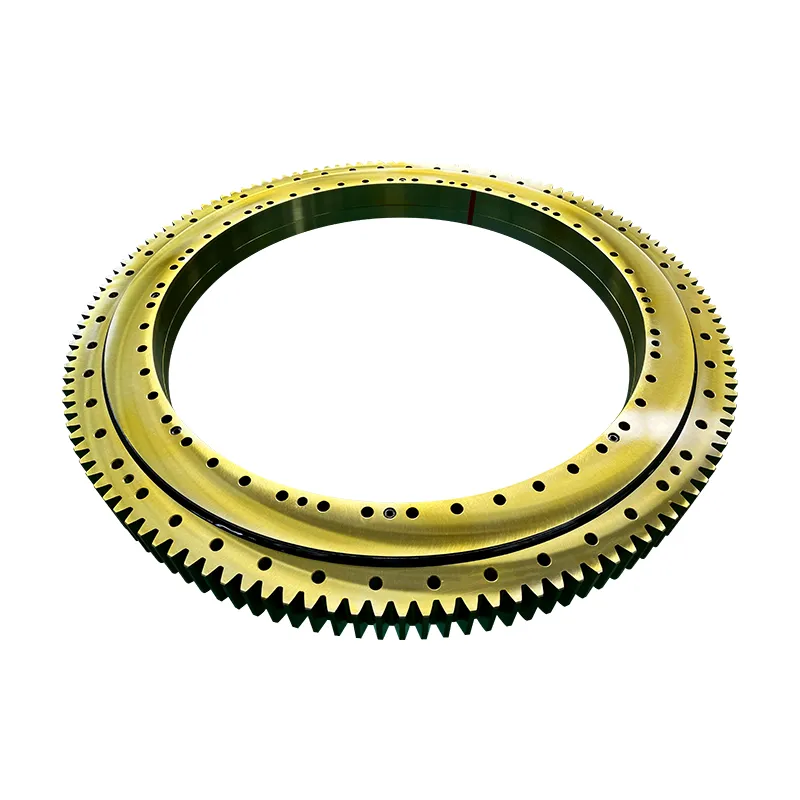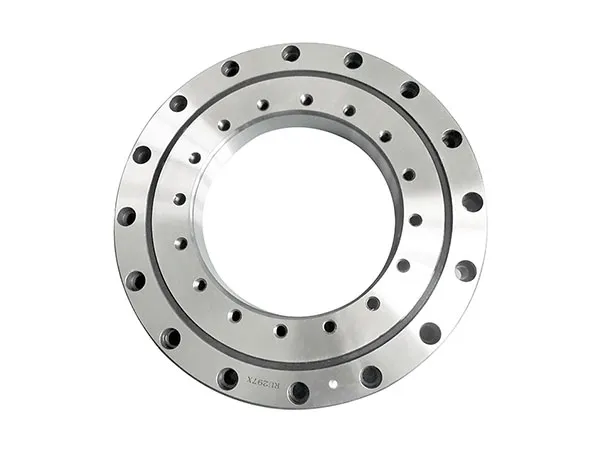- +86 13837949030 +86 15890619536
- info@lymcbearings.com export@lymcbearings.com
- Luoxin Industrial Cluster, Luoyang City,Henan Province,China
Time:2025-07-07 09:08:15 Source:LYMC Slewing Bearing
Double row slewing bearings are essential components in cranes, excavators, wind turbines, and other heavy machinery. They provide smooth rotational movement and support heavy loads. However, abnormal noise is often the first sign of potential problems that, if left unaddressed, can lead to expensive repairs or operational downtime. This guide provides a comprehensive approach to troubleshooting double row slewing bearing noise, identifying causes, and implementing preventive maintenance strategies.

Not all bearing noise is problematic. Understanding the type of noise and when it occurs helps distinguish normal operation from issues requiring attention.
Normal Noise
A slight, uniform rolling sound is common in new bearings due to the movement of steel balls.
This sound typically diminishes after a few rotations as the bearing seats itself.
Abnormal Noise
Grinding,clicking, popping, or cracking indicates potential bearing issues.
Occurrence timing provides clues:
Before/After Installation: Possible deformation during transport or improper mounting.
During Operation: Likely causes include wear, contamination, or insufficient lubrication.
Under Load vs. No Load: Load-dependent noise can point to stress or uneven wear.
Before dismantling the bearing, perform basic checks to isolate the source of noise.
Confirm the Noise Source
Bearings may be mistakenly blamed for sounds originating from other components.
Stop the slewing ring while the rest of the machine operates to isolate the sound.
Check Lubrication
Insufficient or Contaminated Grease: Rolling elements rub, creating noise.Regrease every 100-250 operating hours, or more often in harsh conditions.
Lubricant Type: Use the correct grease with suitable viscosity; the wrong type can cause poor lubrication and noise.
Inspect Purged Grease: Presence of grit, metal particles, or flakes indicates wear or contamination.
Oil Leakage: Damaged seals or improper lubrication practices can result in lubrication loss and noise.
Improper installation can significantly affect bearing performance and generate abnormal sounds.
Uneven Mounting Surface
Negative clearance caused by uneven surfaces leads to localized pressure points.
Solution: Re-machine surfaces to specification or use shims to ensure flatness.
Loose Mounting Bolts
Elastic deformation from loose bolts increases negative clearance and causes noise.
Solution: Tighten all bolts to specified torque values.
Gear Meshing Issues
Misalignment, excessive backlash, or foreign objects in the gear mesh can create loud noise.
Solution: Adjust gear alignment and backlash; remove debris or broken teeth.

Even with proper installation and lubrication, internal bearing issues can occur.
Contamination
Dirt, sand, or metal debris in raceways causes grinding and difficult rotation.
Solution: Thoroughly clean the bearing and replace damaged seals.
Wear and Damage
Cracks, Indentations,Rust: Cause vibrations and clicking sounds.
Severe or Uneven Wear: Leads to wobbling, increased clearance, and loud popping.
Excessive Clearance: Over time, wear increases play, reducing stiffness in booms or equipment arms.
Solution: Repair or replace damaged bearings; measure clearance using a dial indicator for precision.
Spacer Block Issues
Deformed or improperly assembled spacer blocks may block rolling elements, creating abnormal noise.
Solution: Inspect and replace defective blocks.
Sometimes, noise is not caused by the bearing itself.
Design or Load Issues
Incorrect bearing selection or underestimation of loads can lead to premature wear and noise.
Host Machine Vibration
Noise may originate from motors, frames, or other machinery components.
Solution: Isolate the bearing to confirm the actual source.
Proper maintenance reduces noise, prevents damage, and extends the lifespan of your slewing bearings.
Regular Lubrication: Grease bearings based on operating hours and environmental conditions.
Visual Inspection: Look for wear, contamination, or seal damage.
Load Distribution: Avoid repeatedly lifting heavy loads in the same position.
Record-Keeping: Maintain logs of maintenance, inspections, and any abnormal noise.
Professional Inspection: For severe or persistent noise, consult bearing manufacturers for repair or replacement advice.
Safety First: Always follow safety protocols when inspecting heavy machinery.

1) Listen and Observe: Identify noise type, intensity, periodicity, and when it occurs.
2) Check Lubrication:Grease thoroughly; inspect purged grease.
3) Inspect Mounting and Bolts: Ensure flat surfaces and correct torque.
4) Check Seals and Gear Meshing: Replace damaged seals; verify proper gear alignment.
5) Measure Clearance: Use a dial indicator if possible.
6) Consider Internal Damage:Wear or damage may require professional repair or replacement.
7) Consult Manufacturers: Seek expert guidance when in doubt.
Double row slewing bearing noise is a warning sign that should never be ignored. By identifying the type of noise, inspecting lubrication, checking installation, and performing regular maintenance, operators can prevent costly repairs and extend bearing lifespan. Integrating these best practices into your maintenance routine ensures smoother operations, safer machinery, and optimized performance.